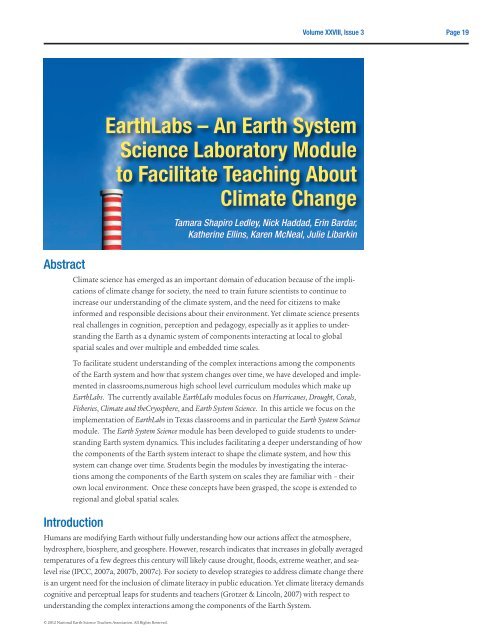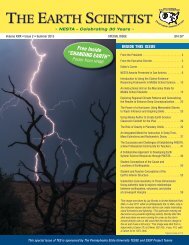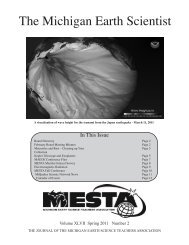The Earth Scientist
Fall 12.pdf - NESTA
Fall 12.pdf - NESTA
- No tags were found...
You also want an ePaper? Increase the reach of your titles
YUMPU automatically turns print PDFs into web optimized ePapers that Google loves.
Volume XXVIII, Issue 3<br />
Page 19<br />
<strong>Earth</strong>Labs – An <strong>Earth</strong> System<br />
Science Laboratory Module<br />
to Facilitate Teaching About<br />
Climate Change<br />
Tamara Shapiro Ledley, Nick Haddad, Erin Bardar,<br />
Katherine Ellins, Karen McNeal, Julie Libarkin<br />
Abstract<br />
Climate science has emerged as an important domain of education because of the implications<br />
of climate change for society, the need to train future scientists to continue to<br />
increase our understanding of the climate system, and the need for citizens to make<br />
informed and responsible decisions about their environment. Yet climate science presents<br />
real challenges in cognition, perception and pedagogy, especially as it applies to understanding<br />
the <strong>Earth</strong> as a dynamic system of components interacting at local to global<br />
spatial scales and over multiple and embedded time scales.<br />
To facilitate student understanding of the complex interactions among the components<br />
of the <strong>Earth</strong> system and how that system changes over time, we have developed and implemented<br />
in classrooms,numerous high school level curriculum modules which make up<br />
<strong>Earth</strong>Labs. <strong>The</strong> currently available <strong>Earth</strong>Labs modules focus on Hurricanes, Drought, Corals,<br />
Fisheries, Climate and theCryosphere, and <strong>Earth</strong> System Science. In this article we focus on the<br />
implementation of <strong>Earth</strong>Labs in Texas classrooms and in particular the <strong>Earth</strong> System Science<br />
module. <strong>The</strong> <strong>Earth</strong> System Science module has been developed to guide students to understanding<br />
<strong>Earth</strong> system dynamics. This includes facilitating a deeper understanding of how<br />
the components of the <strong>Earth</strong> system interact to shape the climate system, and how this<br />
system can change over time. Students begin the modules by investigating the interactions<br />
among the components of the <strong>Earth</strong> system on scales they are familiar with – their<br />
own local environment. Once these concepts have been grasped, the scope is extended to<br />
regional and global spatial scales.<br />
Introduction<br />
Humans are modifying <strong>Earth</strong> without fully understanding how our actions affect the atmosphere,<br />
hydrosphere, biosphere, and geosphere. However, research indicates that increases in globally averaged<br />
temperatures of a few degrees this century will likely cause drought, floods, extreme weather, and sealevel<br />
rise (IPCC, 2007a, 2007b, 2007c). For society to develop strategies to address climate change there<br />
is an urgent need for the inclusion of climate literacy in public education. Yet climate literacy demands<br />
cognitive and perceptual leaps for students and teachers (Grotzer & Lincoln, 2007) with respect to<br />
understanding the complex interactions among the components of the <strong>Earth</strong> System.<br />
© 2012 National <strong>Earth</strong> Science Teachers Association. All Rights Reserved.






